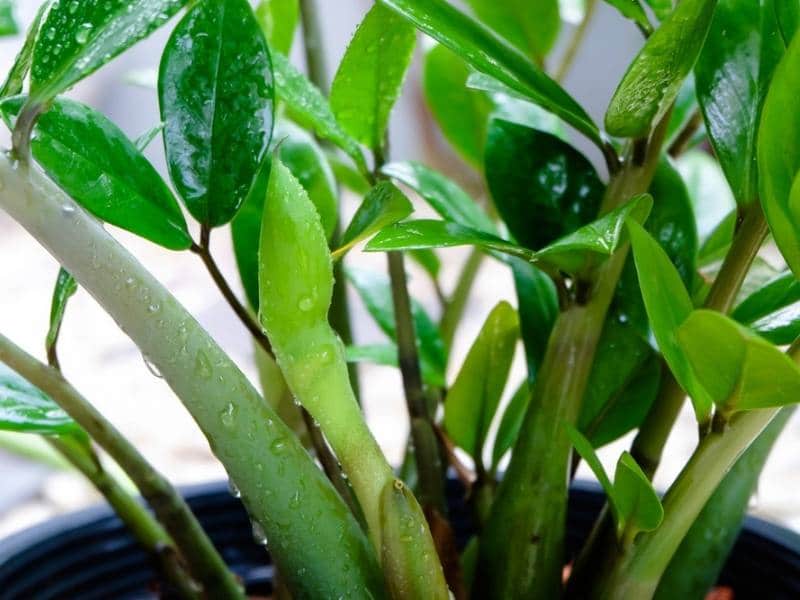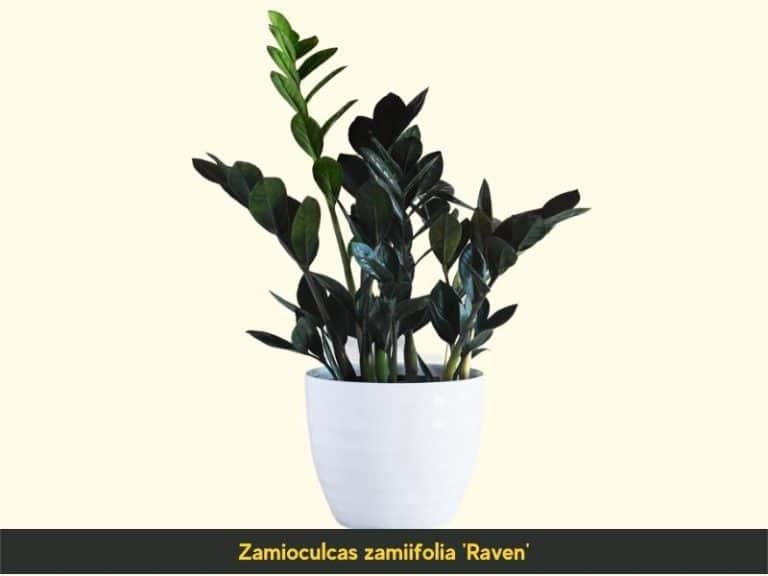ZZ Plant Care – Water, Light, Potting Soil and More
From efficient air-cleaning properties to little maintenance privileges, the benefits that come with growing and caring for a ZZ plant (Zamioculcas zamiifolia) are Dubbed Zanzibar Gem, and native to East Africa, the ZZ plant is hardy plants, allowing them to survive months of drought without sunlight.

The plant:
- Is native to East Africa
- Growing conditions mimic palms (high temperatures and fast-draining soils)
- Has strong wand-like stems
- Has many oval-shaped, glossy and fleshy leaves growing on them
- Produces flowers at the base when grown in its natural habitat or outdoors
- Is toxic to humans and pets
- Makes a nice display on a table area (prefers indoor light)
- Grows slowly (may take 3-5 years to grow into a mature plant), doesn’t need frequent repotting
ZZ Plant Care and Requirements
| Light | Indirect light, near a window or fluorescent lights |
| Water | Deep watering every 4-6 weeks |
| Humidity | Average household humidity |
| Temperature | Warm temperatures between 60 °F and 90 °F |
| Soil type | A mix of organic potting soil, perlite, horticultural charcoal, and orchid bark |
Mimicking the ZZ’s natural habitat guarantees healthy growth and provides you the benefits of growing it as a houseplant. At a glance, the ZZ plant thrives in the following conditions:
Water
The ZZ is a drought-tolerant plant that doesn’t need daily or weekly watering. It has an extremely high-water retention mechanism in the rhizomes. The rhizomes suck up and store as much water as possible to facilitate their preparedness for drought.
Water only when the soil is completely dry throughout the pot. You can test the soil for moisture by dipping your fingers into it. Water the plant deeply 4-6 weeks after aerating the soil.
Overwatering will easily kill your ZZ plant, starting with signs such as rhizome and stem rot, yellow foliage, and drooping leaves.
Underwatering, too, results in crispy and dry leaves. Cut out the dry leaves and roots, then water the plant deeply to ensure the roots absorb enough.

How often should you water your ZZ plant?
The rule of thumb is to water your ZZ plant 1 – 2 times monthly depending on the growing conditions. Water the plant infrequently and let the soil dry out between waterings, especially during winter, in low light, and in highly humid conditions when the pot retains more water than usual.
How much water do ZZ plants require?
The amount of water your ZZ plant requires depends on the size of the pot and plant, the type of potting mix, and the season. As a rule of thumb, water ZZ plants once every 2-3 weeks with as much water as needed to keep the soil moist.
How to tell the plant needs water
Here are signs of a dehydrated Zz plant:
- Droopy or crispy-looking leaves with brown edges
- A lightweight pot
- The two inches of the top soil feels completely dry
Give your plant a drench until the water runs out of the drainage holes.
Light
ZZs are intolerant to direct sunlight unless they receive an eastern exposure during the winter months. Too much direct sun in summer or spring causes whitening and curling in leaves. Slowly, the leaves of the ZZ plant will turn yellow then brown, then wilt out and die. The stems may shift positions to escape the light which is the opposite of how most plants behave.
The ZZ plant can survive in low light but this will stunt its growth. In low light, ZZ’s growth rate slows down, increasing the risk of overwatering. Place the pot near a window that invites indirect light and keep rotating it to ensure all the leaves access the light. If in a windowless office, turn on your fluorescent lights for several hours a day.
Temperature
The ZZ plant will grow rapidly in warm temperatures between 60 °F and 90 °F. The warm temperatures promote its leaf production and promote its drought-tolerance mechanisms. When exposed to chill temperatures below 50 °F, its active growth reduces and will be susceptible to injury.
Humidity
Zanzibar gems prefer average household humidity (between 30% and 40% in winter, and 50% and 60% in summer). If the air molecules in your home feel drier, get a humidifier and place it near your plant. Alternatively, place your ZZ plant on top of a water tray covered with pebbles to increase humidity.
Best pot
ZZ plants aren’t as picky as some plants as far as the potting type is concerned. They can grow in porous materials like terra cotta, concrete, or even coir. However, these materials tend to take away moisture from the soil to unpredictable degrees.
It’s best to put a waterproof saucer underneath the pot to protect your table or floors to prevent moisture from accumulating underneath. On the other hand, plastic may retain moisture for long periods.
Like most plants, growing ZZs prefer a little room to spread their roots and grow. The pot size and type have an effect on your plant’s health. It is better to choose a pot that is bigger (2 inches larger in diameter) than you plant than leaving it to struggle in a small pot.
The best way to know if your ZZ plant has outgrown its pot is if its rhizome is standing or within one inch of the pot wall. Don’t go for an oversized pot either, as this makes it retain water for long periods.
For larger ZZs, repot every 1-2 years. Ensure the pot’s diameter is 2-4 inches larger in diameter. Re-potting works best at the beginning of spring when it’s actively growing. Ensure you re-pot it during the first 3-5 years while it’s still actively growing for the best results. If the pot’s size isn’t anything to worry you about, provide your ZZ plant with a new soil mix. Trim away some rhizomes and foliage.
Soil Type and Drainage
ZZ plants aren’t choosy when it comes to their potting medium, provided the soil peat is fast-draining. Their rhizomes and rootlets are adapted to picking water from the ground like they do in their natural habitat.
However, you might want to consider using a chunky mix of organic potting soil, perlite, horticultural charcoal, and orchid bark when it’s still young. Also, ensure the soil is well-aerated by adding fast-draining soil like sand. This combination allows water to drain fast and creates more space for your ZZ plant to grow and root into.
Misting
Misting isn’t a must for ZZ plants. These plants are heat and drought-tolerant allowing them to survive without water for months. However, low humidity levels will affect their growth. Misting is the only remedy you have at increasing humidity around it. If you live in a drier area, follow these misting steps:
- Get a mister or spray bottle and fill it with lukewarm water
- Spray the ZZ leaves, from the bottom to top
Misting should only apply early in the morning so that your ZZ plant will have the whole day to dry up.
Propagation
Propagation for ZZs can work through stem cuttings or leaf cuttings.
Propagation through stem cuttings works by:
- Cutting off the stalk at the base of your ZZ using a knife cleaned using alcohol
- Immersing the cut stem in water. Ensure you change the water every 3-4 weeks
- Placing the stem cutting near an area inviting indirect light like the window
- Once you see a rhizome growing in your stem cutting, it’s time to pot it
Propagation through leaf cuttings works by:
- Cutting off a matured leaf from the base and removing a bit of its stem (try gambling with many leaves as some of them might not take off)
- Placing the cut end in a dry area to callus over for 3-5 hours (ensure the room is warm and bright)
- Putting the cut leaf’s stem into a potting mix (should be 1cm deep and have moisture). The majority of the leaf should be up.
- Wait for at least four weeks. You’ll see some rhizomes (bulb-like structures) and rootlets forming at the base
Some ZZ species may take up to 9 months to produce rhizomes. As long as the leaves or stems aren’t rotting, you should see some rhizomes appearing.
FAQ
Where should I place my ZZ plant at home?
Situate your ZZ plant in a room with low to bright indirect light. If it’s a small ZZ, place it on a table near the window. If the window invites direct sunlight, cover it with blinds or curtains. Big ZZ plants can be placed on the floor, but ensure you place a waterproof pan underneath the pot to prevent moisture from damaging your floors.
Is a ZZ plant hard to take care of?
ZZ Plants are low-maintenance houseplants, as they can thrive in low light and infrequent watering. Fertilize every 6 months or monthly during the growing season for optimal growth.
Conclusion
Like cacti, ZZ plants are excellent office or houseplant choices for people with busy lifestyles and gardening newbies. Caring for it is easy because it requires infrequent watering, indirect light, average humidity, regular soil mix, little-to-no fertilization, and high temperatures.
It’s also disease-resistant and pest-resistant. Besides its esthetic appeal, it purifies the air, giving you the privilege to live or work in a toxic-free environment.




